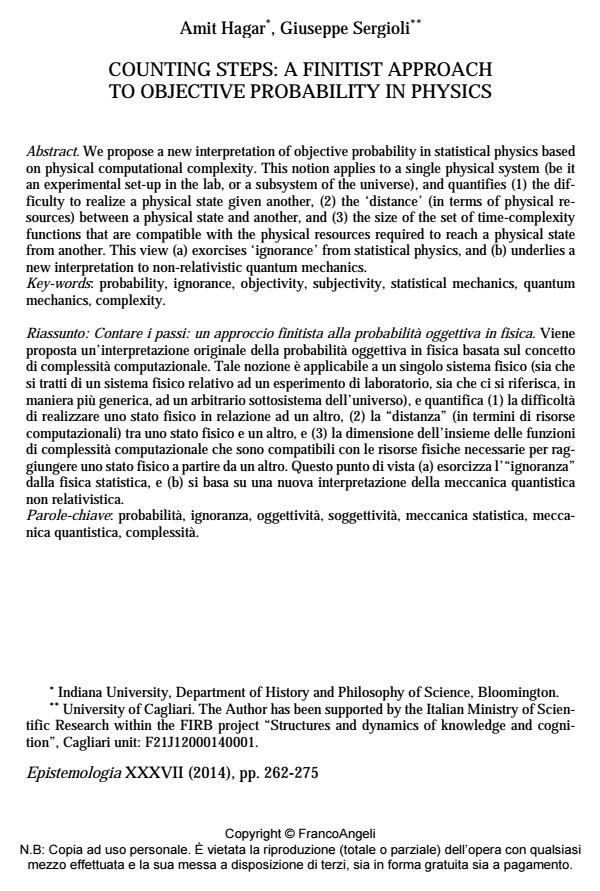Counting steps: a finitist approach to objective probability in physics
Titolo Rivista EPISTEMOLOGIA
Autori/Curatori Amit Hagar, Giuseppe Sergioli
Anno di pubblicazione 2015 Fascicolo 2014/2 Lingua Inglese
Numero pagine 14 P. 262-275 Dimensione file 96 KB
DOI 10.3280/EPIS2014-002006
Il DOI è il codice a barre della proprietà intellettuale: per saperne di più
clicca qui
Qui sotto puoi vedere in anteprima la prima pagina di questo articolo.
Se questo articolo ti interessa, lo puoi acquistare (e scaricare in formato pdf) seguendo le facili indicazioni per acquistare il download credit. Acquista Download Credits per scaricare questo Articolo in formato PDF

FrancoAngeli è membro della Publishers International Linking Association, Inc (PILA)associazione indipendente e non profit per facilitare (attraverso i servizi tecnologici implementati da CrossRef.org) l’accesso degli studiosi ai contenuti digitali nelle pubblicazioni professionali e scientifiche
We propose a new interpretation of objective probability in statistical physics based on physical computational complexity. This notion applies to a single physical system (be it an experimental set-up in the lab, or a subsystem of the universe), and quantifies (1) the difficulty to realize a physical state given another, (2) the ‘distance’ (in terms of physical resources) between a physical state and another, and (3) the size of the set of time-complexity functions that are compatible with the physical resources required to reach a physical state from another. This view (a) exorcises ‘ignorance’ from statistical physics, and (b) underlies a new interpretation to non-relativistic quantum mechanics.
Keywords:Probability, ignorance, objectivity, subjectivity, statistical mechanics, quantum mechanics, complexity.
- Aaronson S. (2009). BQP and the polynomial hierarchy. http://arxiv.org/abs/0910.4698.
- Albert D. (2000). Time and Chance, Harvard, Harvard University Press.
- Beltrametti E., Dalla Chiara M.L., Giuntini R., Leporini R., Sergioli G. (2012a). Epistemic Quantum Computational Structures in a Hilbert-space Environment, Fundamenta Informaticae, 115, pp. 1-14.
- Beltrametti E., Giuntini R., Dalla Chiara M.L., Sergioli G. (2012b). Quantum teleportation and quantum epistemic semantics, Mathematica Slovaca, 62, pp. 1121-1144.
- Buhrman H., Cleve R., Wigderson A. (1998). Quantum vs. classical communication and computation, Proceedings of the 13th annual ACM symposium on Theory of computing, pp. 63-68.
- Caves C., Fuchs C., Schack R. (2002). Quantum probabilities as bayesian probabilities, Physical Review A, 65, 022305.
- Coish H.R. (1959). Elementary Particles in a Finite World Geometry, Physical Review, 114, pp. 383-388.
- Dalla Chiara M.L., Giuntini R., Ledda A., Leporini R., Sergioli G. (2010). Entanglement as a Semantic Resource, Foundations Of Physics, 40(9), pp. 1494-1518.
- Earman J., Norton J. (1993). Forever is a day: supertasks in Pitowsky and Malament-Hogarth spacetimes, Philosophy of Science, 60, pp. 22-42.
- Feynman R. (1982). Simulating physics with computers, International Journal of Theoretical Physics, 21, pp. 467-488.
- Frigg R. (2007). Probability in Bolzmannian statistical mechanics. In Ernst G., Uttemann A.H. (eds.), Time, Chance and Reduction, Philosophical Aspects of Statistical Mechanics, Cambridge, Cambridge University Press.
- Fuchs C. (2010). QBism, the perimeter of Quantum Bayesianism, available at http://arxiv.org/abs/1003.5209.
- Geroch R., Hartle J. (1986). Computability and physical theories, Foundations of Physics, 16(6), pp. 533-550.
- Hagar A. (2003). A philosopher looks at quantum information theory, Philosophy of Science, 70, pp. 752-775.
- Hanson A., Ortiz G., Sabry A., Tai Y. (2013). Geometry of Discrete Quantum Computing, Journal of Physics A: Mathematical and Theoretical, 46(18), pp. 185301.
- Hanson A., Ortiz G., Sabry A., Tai Y. (2013). Discrete Quantum Theories, preprint available at arXiv:1305.3292.
- Hartmanis J., Stearns R.E. (1965). On the computational complexity of algorithms, Transactions of the American Mathematical Society, 117, pp. 285-306.
- Hemmo M., Shenker O. (2012). The Road to Maxwell’s Demon, Cambridge: Cambridge University Press.
- Hilgevoord J. (1998). The uncertainty principle for energy and time, II, American Journal of Physics, 66, p. 396. Hogarth M. (1994). Non-Turing computers and non-Turing computability. In Hull D., Forbes
- M., Burian R.M. (eds.), PSA 1994, vol. 1, pp. 126-138, East Lansing, Philosophy of Science Association.
- Lewis D. (1986). Philosophical Papers, vol. 2, Oxford, Oxford University Press.
- Morris H. (1974). The Present Status of the Coish Model, International Journal of Theoretical Physics, 9(6), pp. 369-377.
- Pitowsky I. (1990). The physical Church thesis and physical computational complexity, Iyyun, 39, pp. 87-99.
- Pitowsky I. (1996). Laplace’s demon consults an oracle: the computational complexity of prediction, Studies in History and Philosophy of Modern Physics, 17, pp. 161-180.
- Pour-el M., Richards I. (1989). Computability in Analysis and Physics, Berlin, Springer.
- Shagrir O., Pitowsky I. (2003). Physical hypercomputation and the Church-Turing thesis, Minds & Machines, 13, pp. 87-101.
- Reisler D., Smith N. (1969). Geometry over a Finite Field. 1969, Defense Technical Information Center OAI-PMH Repository.
- Schwinger J. (2001). Quantum Mechanics: Symbolism of Atomic Measurements, Berlin, Springer.
- Uffink J. (2011). Subjective probability and statistical physics. In Beisbart C., Hartmann S. (eds.), Probabilities in Physics, Oxford, Oxford University Press.
- Van Bendegem J. (2010), Finitism in Geometry. In Zalta E. (ed.), Stanford Encyclopedia for Philosophy.
- Quantum, Probability, Logic Amit Hagar, pp.305 (ISBN:978-3-030-34315-6)
Amit Hagar, Giuseppe Sergioli, Counting steps: a finitist approach to objective probability in physics in "EPISTEMOLOGIA" 2/2014, pp 262-275, DOI: 10.3280/EPIS2014-002006